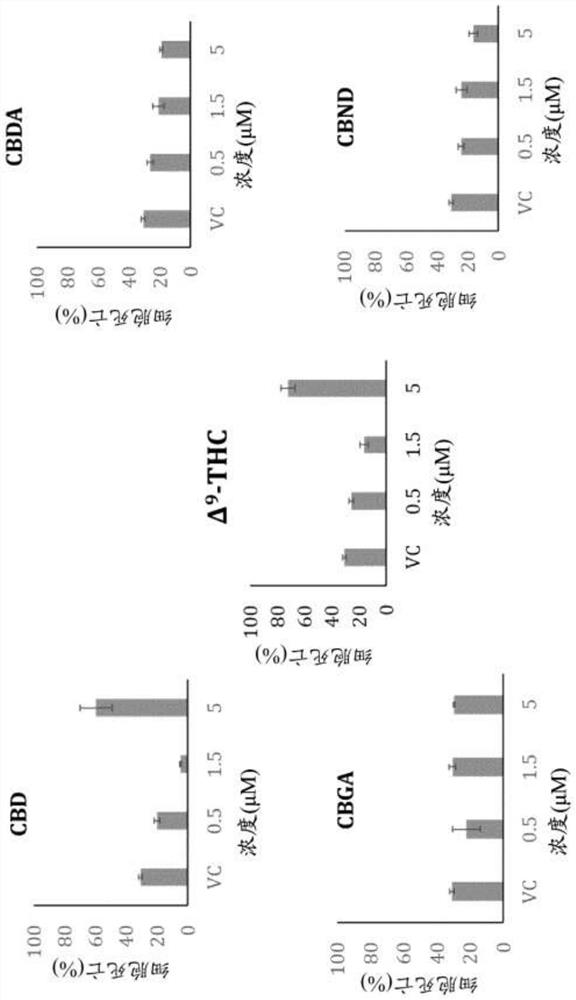Compositions and methods for use of cannabinoids for neuroprotection
A technology for neuroprotection and composition, which can be used in drug combinations, nervous system diseases, nervous system cells, etc., and can solve problems such as excitotoxicity and no neuroprotective effect.
- Summary
- Abstract
- Description
- Claims
- Application Information
AI Technical Summary
Problems solved by technology
Method used
Image
Examples
Embodiment 1
[0147] Example 1: Neuronal Cell Protection with Cannabidiol at Atmospheric Pressure
[0148] Cell Culture and Differentiation: at 37°C in 5% CO 2 The mouse 661W (RGC-5) cell line was maintained in DMEM cell culture medium supplemented with 10% FBS and 1% antibiotic-antimycotic penicillin / streptomycin (growth medium) in a humidified atmosphere. To induce neuronal differentiation in 661W cells, the medium was replaced with growth medium containing 321 nM staurosporine (STSR) and the cells were incubated at 37 °C in 5% CO 2 Incubate for 24 hours in a humidified atmosphere.
[0149] Compounds and formulations for administration: Selected Cannabinoids: CBN, CBD, CBGA, CBDA, CBND and Delta 9 -THC was purchased from Cayman and Toronto Research Chemicals. Ethanol was used as solvent to prepare 1 and 10 mM stock solutions. The treatment concentrations of prepared CBN were 0.015, 0.05, 0.15, 0.5, 1.5, 5, 10 and 15 μM. 0.5, 1.5 and 5 [mu]M treatment concentrations of other can...
Embodiment 2
[0152] Example 2: Neuroprotection of 661W cells by cannabinol under high hydrostatic pressure
[0153] All procedures were carried out as described in Example 1 unless otherwise specified. Differentiated 661W cells treated with corresponding concentrations of cannabinoids were placed in a pressurized chamber where a high hydrostatic pressure of 20-40 mmHg was maintained for 72 hours. At the end of the incubation, 661W cells were processed for MTT assay to determine cytotoxicity. result in Figure 2-Figure 5 shown in .
[0154] In a separate study, concentrations of 0.015, 0.05, 0.15, 0.5, 1.5, 5, 10 and 15 μM of the cannabinol derivative CBNA were placed on differentiated 661W cells in a pressurized chamber in which Maintain high hydrostatic pressure of about 10-25mmHg for 72 hours. At the end of the incubation, 661W cells were processed for MTT assay to determine cytotoxicity. result in Figure 6 shown in .
Embodiment 3
[0155] Example 3: Detection of cannabinoid neuroprotection in 661W cells using an apoptosis assay
[0156] Using Cell-APO Percentage TM Apoptosis is assessed with the Apoptosis Kit, which detects and measures apoptosis by a colorimetric method. The assay uses the Cell-APO Percentage TM Apoptosis system to monitor the occurrence of anchorage-dependent apoptosis in mammalian cells in vitro. It measures the executive phase of apoptosis associated with the translocation of phosphatidylserine from the inner to outer surface of mammalian cell membranes, which is experimentally supported by the binding of annexin V to phosphatidylserine. Transmembrane movement of phosphatidylserine leads to APOPercentage dye uptake by apoptotically committed cells. This dye uptake continues until blebbing occurs and is selectively imported by cells undergoing apoptosis. Necrotic cells cannot retain the dye and therefore will not be stained.
[0157] Apoptosis was assessed in differentiated 661...
PUM
 Login to View More
Login to View More Abstract
Description
Claims
Application Information
 Login to View More
Login to View More - Generate Ideas
- Intellectual Property
- Life Sciences
- Materials
- Tech Scout
- Unparalleled Data Quality
- Higher Quality Content
- 60% Fewer Hallucinations
Browse by: Latest US Patents, China's latest patents, Technical Efficacy Thesaurus, Application Domain, Technology Topic, Popular Technical Reports.
© 2025 PatSnap. All rights reserved.Legal|Privacy policy|Modern Slavery Act Transparency Statement|Sitemap|About US| Contact US: help@patsnap.com



